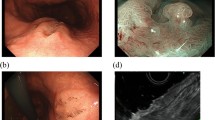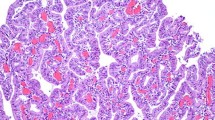Summary
A total of 626 surgically resected gastric carcinomas were reviewed, and 24 cases (3.8%) of “gastric carcinoma with lymphoid stroma” were identified. The tumour cells were consistently arranged in an anastomosing trabecular or alveolar pattern and were densely infiltrated by lymphoid cells. The specimens were studied using mucin histochemistry and the indirect immunoperoxidase method to determine the histochemical properties of this form of gastric carcinoma. The tumour cells were consistently positive for concanavalin A paradoxical staining, class III and almost devoid of acidic mucins, features demonstrating preferential differentiation toward pyloric glands or pseudopyloric glands. Immunohistochemically, positive reactions for Leu M1 and lysozyme, marker substances of (pseudo)pyloric gland cells, were often observed. Carcinoembryonic antigen was positive in focal areas without (pseudo)pyloric glandular patterns. Secretory component was focally positive. HLA-DR was strongly expressed in most cancer cells and 17 tumours (71%) showed positivity for interleukin 1 (IL-1). The lymphoid stroma contained a high percentage of UCHL1-reactive T cells both within and around the cancer cell nests, while SL26-reactive B cells clustered in lymphoid follicles. A considerable number of T-lymphoid cells were also reactive for IL-1. A number of plasma cells with a predominance of IgG-type were distributed around the cancer cell nests. S-100 protein-positive dendritic cells were not identified. We speculate that the prominent lymphoid stroma including intraepithelial lymphocyte-like T cells with IL-1 receptors is possibly induced by IL-1 related mediators released from the HLA-DR-positive gastric cancer cells of the (pseudo)pyloric gland-type.
Similar content being viewed by others
References
Bland PW, Warren LG (1986) Antigen presentation by epithelial cells of the rat small intestine. II. Selective induction of suppressor T cells. Immunology 58:9–14
Cerf-Bensussan N, Schneeberger EE, Bhan AK (1983) Immunohistologic and immunoelectron microscopic characterization of the mucosal lymphocytes of human small intestine by the use of monoclonal antibodies. J Immunol 130:2615–2622
Cerf-Bensussan N, Quaroni A, Kurnick JT, Bhan AK (1984) Intraepithelial lymphocytes modulate Ia expression by intestinal epithelial cells. J Immunol 132:2244–2252
Doughlas AP, Weetman AP (1975) Lymphocyte and the gut. Digestion 13:344–371
Dower SK, Urdal DL (1987) The interleukin-1 receptor. Immunol Today 8:46–51
Duijivestijn AM, Horst E, Pals ST, Rouse BN, Steere AC, Picker LJ, Meijer CJLM, Butcher EC (1988) High endothelial differentiation in human lymphoid and inflammatory tissue defined by monoclonal antibody HECA-452. Am J Pathol 130:147–155
Fukamachi H (1986) Disorganization of stroma alters epithelial differentiation of the glandular stomach in adult mice. Cell Tiss Res 243:65–68
Hamazaki M, Sawayama K, Kuriya T (1968) “Medullary carcinoma with lymphoid infiltration” of stomach. J Karyopathol 12:115–120 (in Japanese)
Heidl G, Davaris P, Zwadlo G, Jagoda MS, Duchting S, Bierhoff E, Gruter T, Krieg V, Sorg C (1987) Association of macrophages detected with monoclonal antibody 25F9 with progression and pathobiological classification of gastric carcinoma. J Cancer Res Clin Oncol 113:567–572
Hirata I, Berrebi G, Austin LL, Keren DF, Dobbins WO III (1986) Immunohistological characterization of intraepithelial and lamina propria lymphocytes in control ileum and colon and in inflammatory bowel disease. Digest Dis Sci 31:593–603
Isaacson P (1982) Immunoperoxidase study of the secretory immunoglobulin system and lysozyme in normal and diseased gastric mucosa. Gut 23:578–588
Katsuyama T, Ono K, Nakayama J, Kanai M (1985) Recent advances in mucosubstance histochemistry. In: Kawai K (ed) Gastric Mucus and Mucus Secreting cells. Excerpta Medica, Tokyo, pp 3–18
Kurtin PJ, Pinkus GS (1985) Leukocyte common antigen. A diagnostic discriminant between hematopoietic and nonhematopoietic neoplasms in paraffin sections using monoclonal antibodies. Correlation with immunologic studies and ultrastructural localization. Human Pathol 16:353–365
Kyogoku M, Sawai T, Mori S (1987) Defensive tissue response in human. Reactions before inflammation and “interstitial cells”. Nihon Rinsho 45:939–953 (in Japanese)
MacCarty WC, Mahle AE (1921) Relation of differentiation and lymphocytic infiltration to postoperative longevity in gastric carcinoma. J Lab Clin Med 6:473–480
McDonald GB, Jewell DP (1987) Class II antigen (HLA-DR) expression by intestinal epithelial cells in inflammatory diseases of colon. J Clin Pathol 40:312–317
Moore OS Jr, Foote FW Jr (1949) The relativity favorable prognosis of medullary carcinoma of the breast. Cancer 2:635–642
Nagura H, Sumi Y (1987) Immunocytochemical studies of the vascular endothelial cells in human Peyer's patches and solitary lymphoid follicles. In: Mesdecky J, McGhee JR, Bienenstock J, Ogra PL (eds) Recent Advances in Mucosal Immunity. Plenum Publishers, New York, pp 279–286
Nakamura S, Sumi Y, Nagura H (1988) Ontogenic development of gut-associated lymphoid tissue of the rat: An immunohistochemical study. Acta Pathol Jpn 38:1267–1283
Norton AJ, Ramsay AD, Smith SH, Beverely PCL, Isaacson PG (1986) Monoclonal antibody (UCHL1) that recognizes normal and neoplastic T cells in routinely fixed tissues. J Clin Pathol 39:399–405
Okamura T, Kodama Y, Kamegawa T, Sano C, Kumashiro R, Inokuchi K (1983) Gastric carcinoma with lymphoid stroma: Correlation to reactive hyperplasia in regional lymph nodes and prognosis. Jpn J Surg 13:177–183
Okon E, Felder B, Epstein A, Marder R, Lukes R, Tyler C (1985) Monoclonal antibodies reactive with B lymphocytes and histiocytes in paraffin sections. Cancer 56:95–104
Schultz RM (1987) Interleukin-1 and interferon-α: Cytokines that provide reciprocal regulation of macrophage and T cell function. Toxicol Pathol 15:333–337
Sheibani K, Battifora H, Burke JS, Rappaport H (1986) Leu M1 antigen in human neoplasms. An immunohistologic study of 400 cases. Am J Surg Pathol 10:227–236
Spencer J, Pugh S, Isaacson PG (1986) HLA-D region antigen expression on stomach epithelium in absence of autoantibodies. Lancet 8513:983
Steiner PE, Maimon SN, Palmer WL, Kirsner JB (1948) Gastric cancer: Morphologic factors in five-year survival after gastrectomy. Am J Pathol 24:947–969
Takami T, Ishii Y, Yuasa H, Kikuchi K (1985) Three distinct antigen systems on human B cell subpopulations as defined by monoclonal antibodies. J Immunol 134:828–834
Tamaoki N (1985) Pathology of human neoplasms heterotransplantable to nude mice. An experimental approach to pathology of cancer-bearing individuals. Tr Soc Pathol Jpn 93:93–125 (in Japanese)
Tsujitani S, Furukawa T, Tamada R, Okamura T, Yasumoto K, Sugimachi K (1987) Langerhans cells and prognosis in patients with gastric carcinoma. Cancer 59:501–505
Tsutsumi Y (1986) Pathophysiological significance of intestinal metaplasia of the gastric mucosa: An immunohistochemical approach. In: Kasuya Y, Tsuchiya M, Nagao F, Matsuo Y (eds) Gastrointestinal Function. Regulation and Disturbances, vol 4, Excerpta Medica, Tokyo, pp 15–37
Tsutsumi Y (1988) Differentiation of gastric cancer cells: Analysis using immunohistochemistry and mucin histochemistry. In: Watanabe S, Wolff M, Sommers SC (eds) Digestive Disease Pathology, vol 1. Field and Rich Inc, New York, pp 1–49
Tsutsumi Y, Nagura H, Watanabe K (1984a) Immunohistochemical observations of carcinoembryonic antigen (CEA) and CEA-related substances in normal and neoplastic pancreas. Pitfalls and caveats in CEA immunohistochemistry. Am J Clin Pathol 82:535–542
Tsutsumi Y, Nagura H, Watanabe K (1984b) Immune aspects of intestinal metaplasia of the stomach:An immunohistochemical study. Virchows Arch [Pathol Anat] 403:345–359
van den Hooff A (1984) The part played by the stroma in carcinogenesis. Perspect Biol Med 27:498–509
Watanabe H, Enjoji M, Imai T (1976) Gastric carcinoma with lymphoid stroma. Its morphologic characteristics and prognostic correlations. Cancer 38:232–243
Author information
Authors and Affiliations
Rights and permissions
About this article
Cite this article
Lertprasertsuke, N., Tsutsumi, Y. Gastric carcinoma with lymphoid stroma. Vichows Archiv A Pathol Anat 414, 231–241 (1989). https://doi.org/10.1007/BF00822027
Received:
Accepted:
Issue Date:
DOI: https://doi.org/10.1007/BF00822027




